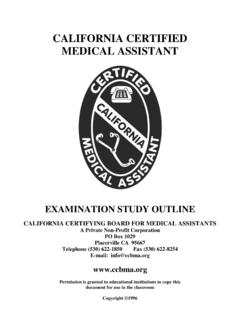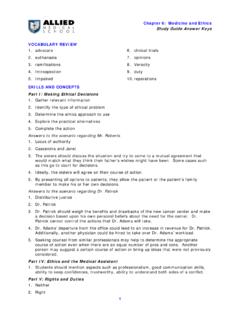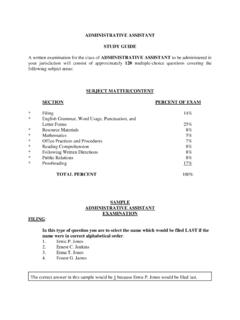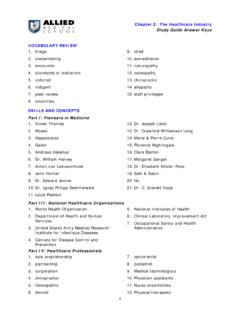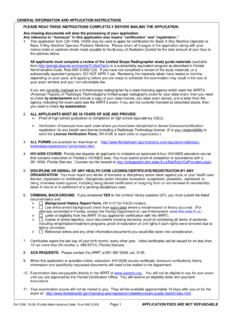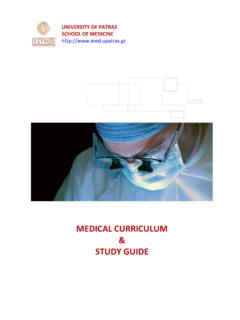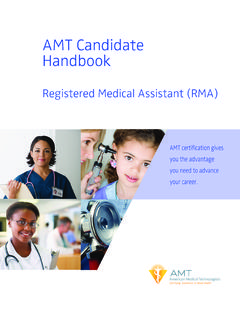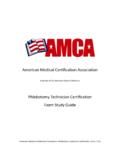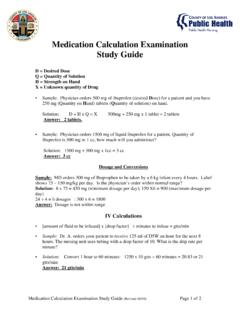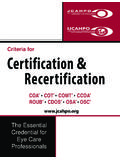Transcription of BASIC ANATOMY & MEDICAL TERMINOLOGY
1 Copyright 2012 American Association Of MEDICAL Personnel All Rights Reserved MEDICAL assistant study guide BASIC ANATOMY & MEDICAL TERMINOLOGY 1) Which of the following suffixes means lack of strength ? A. algia B. tomy C. asthenia D. trophy E. phasia 2) The body cavity that contains the intestines is the A. Thoracic B. Spinal C. Abdominal D. Pleural E. Peritoneal 3) The abbreviation as used in prescriptions, means A. Every hour B. Every two hours C. Twice a day D. Four times a day E. Every other day 4) The pacemaker of the heart is the A. Septum Copyright 2012 American Association Of MEDICAL Personnel All Rights Reserved B. SA node C.
2 AV node D. Left atrium E. Mitral valve 5) Which of the following suffixes refers to pain? A. phagea B. desis C. pnea D. algia E. lysis 6) The organs of the respiratory system include all of the following except A. Larynx B. Pharynx C. Trachea D. Bronchi E. Thoracic duct 7) Which of the following terms means cell eating ? A. Pinocytosis B. Phagocytosis C. Exocytosis D. Endocytosis E. Cytokinesis 8) Which of the following is not a body plane? A. Dorsal B. Frontal C. Sagittal D. Transverse E. They are all body planes Copyright 2012 American Association Of MEDICAL Personnel All Rights Reserved 9) The suffix kinesia means A. Mind B. Muscle C.
3 Pain D. Touch E. Movement 10) The abbreviation meaning immediately is A. prn B. stat C. qod D. ad lib E. dc 11) Which of the following is not a type of muscle tissue? A. Striated B. Visceral C. Skeletal D. Smooth E. Patella 12) The prefix milli- means A. One-thousandth B. Many C. One D. One-hundredth E. One-tenth LAW & ETHICS 1) Professional negligence is also called Copyright 2012 American Association Of MEDICAL Personnel All Rights Reserved A. Malpractice B. Malfunction C. Malice D. Arbitration E. Felony 2) Legally, a physician A. May not refuse treatment in an emergency situation B. May refuse to provide follow-up care after initial treatment C.
4 Must provide a diagnosis to a patient s employer if requested D. Must provide a MEDICAL history to the patient s insurance company if the insurance company requests it E. May choose to accept a patient if he or she chooses 3) Good Samaritan laws A. Encourage physicians to render emergency first aid B. Exist in all 50 states C. Protect physicians against liability for negligence in certain circumstances D. Deal with the treatment of accident victims E. All of the above 4) A crime punishable by a fine or imprisonment for less than one year is known as a A. Misdemeanor B. Felony C. Mitigation D. Mutual assent Copyright 2012 American Association Of MEDICAL Personnel All Rights Reserved E.
5 Arbitration 5) All of the following are reasons for revoking a physician s license except A. Mental incapacity B. Physical incapacity C. Conviction of a crime D. Unprofessional conduct E. Providing atypical care 6) Which of the following items is the most important for MEDICAL assistants to keep in mind during their daily work routine in MEDICAL offices? A. Burglary B. Confidentiality C. Privilege granted to a physician D. Consent E. Good Samaritan laws 7) The patient s MEDICAL record belongs to A. The patient s spouse B. The physician C. The patient D. The patient s attorney E. The state MEDICAL board 8) In cases of malpractice involving res ipsa loquitur, A.
6 The patient has the burden of proving the physician s negligence B. The physician has the burden of proving his or her innocence C. The physician is not bound by physician-patient confidentiality Copyright 2012 American Association Of MEDICAL Personnel All Rights Reserved D. All of the above E. None of the above 9) If a patient refuses to consent to treatment, the MEDICAL assistant should A. Schedule the patient for another appointment B. Force treatment on the patient C. Force the patient to consent D. Delay treatment and inform/consult the physician E. Terminate the patient 10) The Uniform Anatomical Gift Act includes the provision that A. Physicians who accept organs and tissue in good faith, relying on apparently valid documents, are protected from lawsuits B.
7 The time of death must be determined by a physician C. Any person over 18 years of age may give all or any part of his or her body up after death for research or transplantation D. Both A and C E. All of the above PHARMACOLOGY 1) Which route is involved in administering a drug by placing it under the patient s tongue and leaving it there until it is dissolved? A. Buccal route B. Sublingual route C. Subcutaneous route Copyright 2012 American Association Of MEDICAL Personnel All Rights Reserved D. Lozenge route E. Transdermal route 2) The angle for the insertion of the needle for an ID injection is A. 10 15 degrees B. 20 30 degrees C. 45 degrees D.
8 90 degrees E. Not important 3) Which of the following drug types is used to reduce cholesterol? A. Hypolipidemic B. Anticoagulant C. Antiarrhythmic D. Cholinergic E. Antisecretory 4) The amount of time required for 50% of a drug to be eliminated from the body is called A. Half-life B. Effective dose 50 (ED50) C. Lethal dose 50 (LD50) D. Dosage E. Half dosage 5) The main body part involved in the metabolism of drugs is the A. Stomach B. Kidney C. Small intestine D. Large intestine E. Liver Copyright 2012 American Association Of MEDICAL Personnel All Rights Reserved 6) To administer an intramuscular injection, which needle would you use? A. 1 inch, 25 gauge B.
9 1 inch, 21 gauge C. 1 inch, 18 gauge D. inch, 22 gauge E. 2 inch, 20 gauge 7) A chemical substance that interferes with the development of bacterial organisms is A. Antiinflammatory B. Antiviral C. Antisecretory D. Antiepileptic E. Antibiotic 8) In the Physicians Desk Reference, the index of brand names and generic names for drugs is found in which section? A. White B. Blue C. Pink D. All of the above E. None of the above 9) Drugs that increase urine secretion are A. Laxatives B. Diuretics C. Hypolipidemics D. Cromolyns E. Uremics 10) The study of natural drugs is called Copyright 2012 American Association Of MEDICAL Personnel All Rights Reserved A.
10 Pharmacology B. Toxicology C. Posology D. Pharmacognosy E. Pharmacokinetics EXAMINATION ROOM 1) Which of the following thermometers is considered the most accurate indicator of body temperature? A. Oral B. Aural or tympanic C. Axillary D. Rectal E. Both A and B 2) Disposable single-use gloves should be worn A. When taking a blood pressure B. When handling specimens C. When performing venipuncture D. All of the above E. B and C 3) Which of the following is not considered a vital sign? A. Blood pressure B. Pulse rate C. Body temperature D. Respiration rate E. Weight 4) The pulse pressure is Copyright 2012 American Association Of MEDICAL Personnel All Rights Reserved A.


